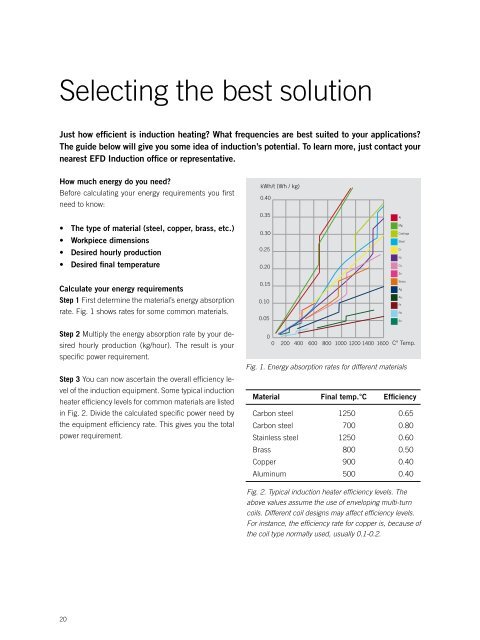Induction heating applications
Induction heating applications
Induction heating applications
Create successful ePaper yourself
Turn your PDF publications into a flip-book with our unique Google optimized e-Paper software.
Selecting the best solution<br />
Just how efficient is induction <strong>heating</strong>? What frequencies are best suited to your <strong>applications</strong>?<br />
The guide below will give you some idea of induction’s potential. To learn more, just contact your<br />
nearest EFD <strong>Induction</strong> office or representative.<br />
How much energy do you need?<br />
Before calculating your energy requirements you first<br />
need to know:<br />
• The type of material (steel, copper, brass, etc.)<br />
• Workpiece dimensions<br />
• Desired hourly production<br />
• Desired final temperature<br />
Calculate your energy requirements<br />
Step 1 First determine the material’s energy absorption<br />
rate. Fig. 1 shows rates for some common materials.<br />
Step 2 Multiply the energy absorption rate by your desired<br />
hourly production (kg/hour). The result is your<br />
specific power requirement.<br />
Step 3 You can now ascertain the overall efficiency level<br />
of the induction equipment. Some typical induction<br />
heater efficiency levels for common materials are listed<br />
in Fig. 2. Divide the calculated specific power need by<br />
the equipment efficiency rate. This gives you the total<br />
power requirement.<br />
20<br />
kWh/t (Wh / kg)<br />
0.40<br />
0.35<br />
0.30<br />
0.25<br />
0.20<br />
0.15<br />
0.10<br />
0.05<br />
0<br />
0 200 400 600 800 1000 1200 1400 1600 C° Temp.<br />
Al<br />
Mg<br />
Castings<br />
Steel<br />
Cr<br />
Ni<br />
Cu<br />
Zn<br />
Brass<br />
Ag<br />
Au<br />
Pt<br />
Pb<br />
Fig. 1. Energy absorption rates for different materials<br />
Material Final temp.°C Efficiency<br />
Carbon steel 1250 0.65<br />
Carbon steel 700 0.80<br />
Stainless steel 1250 0.60<br />
Brass 800 0.50<br />
Copper 900 0.40<br />
Aluminum 500 0.40<br />
Fig. 2. Typical induction heater efficiency levels. The<br />
above values assume the use of enveloping multi-turn<br />
coils. Different coil designs may affect efficiency levels.<br />
For instance, the efficiency rate for copper is, because of<br />
the coil type normally used, usually 0.1-0.2.<br />
Sn


